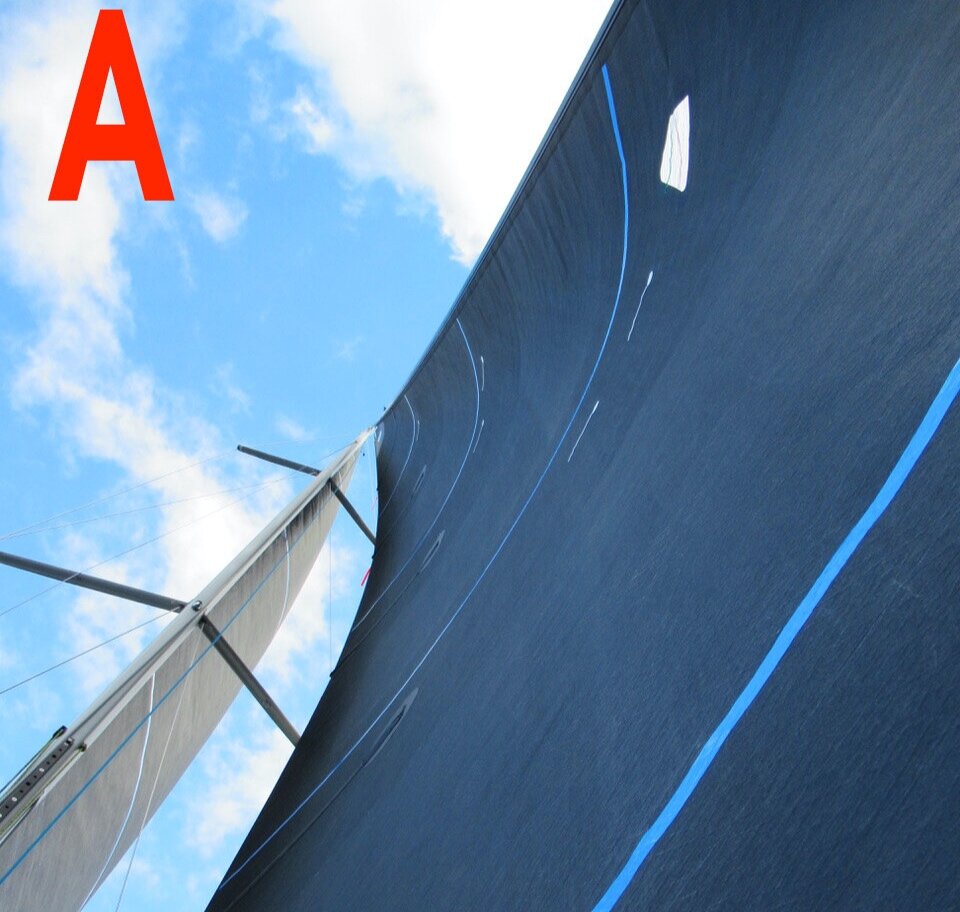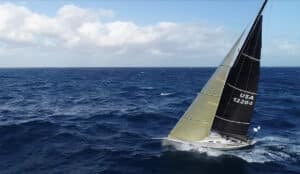Barry Hayes (UK Sailmakers Ireland) and Pat Considine (UK Sailmakers Chicago) explain headsail vertical camber and why it’s so important to boat speed and. Understanding headsail vertical camber is the modern headsail trimmer’s main tool to getting optimum speed and power out of the sail.
Headsail horizontal camber is always spoken about regarding how the sail needs to develop the right shape; but vertical camber is also critical to the performance of the sail.
UK Sailmakers’ sail designers use vertical camber tools in their design program to optimize a sail’s horizontal camber. The superior shape-holding characteristics of today’s moulded sails require proper setting of the car, halyard, and inhauler to get the horizontal and vertical camber correct.
In the Photo B, the red line indicates the sail’s vertical camber. The trimmer’s goal is to get the vertical camber line smooth and straight (as a plane’s wing), while keeping the twist in the leech of the headsail and getting the top of the headsail to open up and match the main sail slot (green line). Looking at the back side of the headsail will help you see the vertical camber and see how deep the sail is. When you’re looking for max power for the pressure you’re in, you want to visualize a straight line down the back of the sail to the deck.
Photo C: Setting-up a headsail to achieve correct vertical and horizontal camber is the key to power-generating headsail trim. There is nothing wrong by having the foot full in the headsail in light air, it’s like having the flaps down on a planes wing when taking off to generate lift and power. In a headsail, a full foot provides power and pushes the bow down in light airs helping to balance the boat. It’s only when the boat reaches hull speed that you need to flatten the horizontal camber in the sail, taking more foot round out of the headsail, and flattening the overall shape of the sail. To flatten the sail, tighten the halyard, sheet harder, and ease inhauler. Begin flattening the sail when the wind reaches 8 – 10 knots.
In Photo D you can see the sail is twisting open, much like the ailerons on a plane’s wing, allowing the air flow to accelerate into the slot. This is the perfect amount of twist-to-vertical camber relationship in the sail. Having too little twist in the head will choke the slot and not allow the air flow to accelerate. To build boat speed, open the slot a little more as this will increase the air flow. When you’re up to speed, reduce the twist again so you’re making the most efficient use of the slot. Actively opening and closing the slot as speed and wind pressure vary, while minding vertical and horizontal camber, will allow you to get the maximum power out of your headsail.
As you can see in the Photo E, the First 50 MERMAID has excellent vertical camber. The headsail is almost touching the lifelines in 8 knots of wind. The leech is nicely twisted open which creates max power and aerodynamic performance.
As you get up past hull speed in heavier airs, you need to shift your focus with your headsail trim. Creating the least amount of drag possible and with the most efficient drive and leeway.
As you can see in the photo of a J3 headsail below, the foot still has shape to match the vertical camber. The sail is not over inhauled so the boat is balanced and easy to steer upwind. Having the foot too flat and not match the vertical camber in the sail will not give the helm enough power to push the boat through waves and also increases the heeling effect. Remember, you need some power in the foot of the headsail to balance the vertical airflow in the headsail. If the sail is too flat in the foot, the airflow will separate too early creating a vacuum and slowing the boat down.
Photo F: Pat Considine, UK Sailmakers’ lead sail designer, added, “From an aerodynamic point-of-view, your objective is to have the foot of the headsail full in light airs and having the top of the leech twist open nicely (see photo below). This allows the headsail to deliver the most power without causing too much drag. You also can see in the photo how the air flow exits the top of the slot and flows quickly around the mainsail. At the same time, the lower portion of the sail’s air flow is moving at half the speed, generating power with smooth vertical camber in the headsail.”
Photo G: Having too little foot round in the headsail is sub-optimal because it reduces the overall vertical camber in the headsail and reduces the power generated by the airflow moving over the headsail. Conversely, in 12 knots, having too much foot found not enough leech twist will give you lift but at the expense of speed.
The ratio of vertical camber to leech twist is critical. Having a straight line down to the deck is a really good visual key to help you get the headsail trim right. While watching the twist in the top of the leech.





Interesting. But I wish I could understand the concept.
Interesting. But I wish I could understand the concept.
excellent article
excellent article
I think I’d need a lesson aboard to get this right.
I think I’d need a lesson aboard to get this right.
Maybe more than 1 lesson. I’m a slow learner.
Maybe more than 1 lesson. I’m a slow learner.
In a headsail, a full foot provides power and pushes the bow down in light airs
What does "pushes the bow down" mean?
In a headsail, a full foot provides power and pushes the bow down in light airs
What does "pushes the bow down" mean?
Great article with lots of things to try. When explaining sail trim to new sailors I like to use the high school science experiment analogy. Change one sail variable across the boat and check speed. Modify if necessary and recheck.in the desire to satisfy many new trimmers change too many settings too often.
Perhaps some extra explanation about the role of in haulers where fitted versus car fwd/back position would be useful. Many thanks. Now to get sailing when we’re stuck onshore on covid 19 restrictions (Melbourne AUS) Can you help with this as well? (lol)
Great article with lots of things to try. When explaining sail trim to new sailors I like to use the high school science experiment analogy. Change one sail variable across the boat and check speed. Modify if necessary and recheck.in the desire to satisfy many new trimmers change too many settings too often.
Perhaps some extra explanation about the role of in haulers where fitted versus car fwd/back position would be useful. Many thanks. Now to get sailing when we’re stuck onshore on covid 19 restrictions (Melbourne AUS) Can you help with this as well? (lol)
fantastic article :). Well done
fantastic article :). Well done
could you add a vertical shape measurer to accumeasure?
could you add a vertical shape measurer to accumeasure?